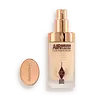Charlotte Tilbury Airbrush Flawless Foundation Versus Clinique Even Better Glow™ Light Reflecting Makeup Broad Spectrum SPF 15
What's inside
What's inside
 Key Ingredients
Key Ingredients

 Benefits
Benefits

 Concerns
Concerns

 Ingredients Side-by-side
Ingredients Side-by-side

Water
Skin ConditioningCyclopentasiloxane
EmollientIsododecane
EmollientPEG-10 Dimethicone
Skin ConditioningPropanediol
SolventPolyglyceryl-4 Isostearate
EmulsifyingSilica
AbrasiveNylon-12
Phenoxyethanol
PreservativeDisteardimonium Hectorite
StabilisingPolysorbate 20
EmulsifyingDimethyl Isosorbide
SolventDimethicone Crosspolymer
Emulsion StabilisingTriethoxycaprylylsilane
Menthyl PCA
HumectantSodium Dehydroacetate
PreservativeArginine PCA
HumectantAluminum Hydroxide
EmollientTocopheryl Acetate
AntioxidantParfum
MaskingIsomalt
HumectantSodium Phytate
Phaeodactylum Tricornutum Extract
HumectantAcetyl Tetrapeptide-11
Skin ConditioningAcetyl Tetrapeptide-9
Skin ConditioningAlcohol
AntimicrobialPhytol
EmollientAlpha-Isomethyl Ionone
PerfumingBenzyl Salicylate
PerfumingCitronellol
PerfumingLimonene
PerfumingCI 77891
Cosmetic ColorantIron Oxides
Water, Cyclopentasiloxane, Isododecane, PEG-10 Dimethicone, Propanediol, Polyglyceryl-4 Isostearate, Silica, Nylon-12, Phenoxyethanol, Disteardimonium Hectorite, Polysorbate 20, Dimethyl Isosorbide, Dimethicone Crosspolymer, Triethoxycaprylylsilane, Menthyl PCA, Sodium Dehydroacetate, Arginine PCA, Aluminum Hydroxide, Tocopheryl Acetate, Parfum, Isomalt, Sodium Phytate, Phaeodactylum Tricornutum Extract, Acetyl Tetrapeptide-11, Acetyl Tetrapeptide-9, Alcohol, Phytol, Alpha-Isomethyl Ionone, Benzyl Salicylate, Citronellol, Limonene, CI 77891, Iron Oxides
Ethylhexyl Methoxycinnamate 6%
UV AbsorberTitanium Dioxide 3.8%
Cosmetic ColorantZinc Oxide 3%
Cosmetic ColorantMethyl Trimethicone
Skin ConditioningPhenyl Trimethicone
Skin ConditioningTriethylhexanoin
MaskingDimethicone
EmollientButylene Glycol
HumectantTrimethylsiloxysilicate
EmollientPEG-10 Dimethicone
Skin ConditioningLauryl PEG-9 Polydimethylsiloxyethyl Dimethicone
Skin ConditioningAluminum Hydroxide
EmollientC12-15 Alkyl Benzoate
AntimicrobialGlycerin
HumectantCitrus Grandis Peel Extract
AstringentBetula Alba Bark Extract
MaskingSaccharomyces Lysate Extract
HumectantCamellia Sinensis Leaf Extract
AntimicrobialAstrocaryum Murumuru Seed Butter
EmollientYeast Extract
Skin ConditioningSalicylic Acid
MaskingSodium Hyaluronate
HumectantCaprylyl Glycol
EmollientJojoba Esters
EmollientSodium Myristoyl Sarcosinate
CleansingSodium Chloride
MaskingTocopheryl Acetate
AntioxidantAcetyl Glucosamine
Skin ConditioningCaprylyl Methicone
Skin ConditioningPolyglyceryl-6 Polyricinoleate
EmulsifyingMethicone
EmollientDimethicone Crosspolymer-3
Skin ConditioningLecithin
EmollientMagnesium Ascorbyl Phosphate
AntioxidantTetrahexyldecyl Ascorbate
AntioxidantDisteardimonium Hectorite
StabilisingIsopropyl Titanium Triisostearate
EmollientLaureth-7
EmulsifyingDipropylene Glycol
HumectantDimethicone/PEG-10/15 Crosspolymer
Disodium EDTA
Phenoxyethanol
PreservativeMica
Cosmetic ColorantCI 77891
Cosmetic ColorantCI 77163
Cosmetic ColorantCI 77492
Cosmetic ColorantCI 77491
Cosmetic ColorantCI 77499
Cosmetic ColorantEthylhexyl Methoxycinnamate 6%, Titanium Dioxide 3.8%, Zinc Oxide 3%, Methyl Trimethicone, Phenyl Trimethicone, Triethylhexanoin, Dimethicone, Butylene Glycol, Trimethylsiloxysilicate, PEG-10 Dimethicone, Lauryl PEG-9 Polydimethylsiloxyethyl Dimethicone, Aluminum Hydroxide, C12-15 Alkyl Benzoate, Glycerin, Citrus Grandis Peel Extract, Betula Alba Bark Extract, Saccharomyces Lysate Extract, Camellia Sinensis Leaf Extract, Astrocaryum Murumuru Seed Butter, Yeast Extract, Salicylic Acid, Sodium Hyaluronate, Caprylyl Glycol, Jojoba Esters, Sodium Myristoyl Sarcosinate, Sodium Chloride, Tocopheryl Acetate, Acetyl Glucosamine, Caprylyl Methicone, Polyglyceryl-6 Polyricinoleate, Methicone, Dimethicone Crosspolymer-3, Lecithin, Magnesium Ascorbyl Phosphate, Tetrahexyldecyl Ascorbate, Disteardimonium Hectorite, Isopropyl Titanium Triisostearate, Laureth-7, Dipropylene Glycol, Dimethicone/PEG-10/15 Crosspolymer, Disodium EDTA, Phenoxyethanol, Mica, CI 77891, CI 77163, CI 77492, CI 77491, CI 77499
Ingredients Explained
These ingredients are found in both products.
Ingredients higher up in an ingredient list are typically present in a larger amount.
Aluminum Hydroxide is a form of aluminum. It can be naturally found in nature as the mineral gibbsite. In cosmetics, Aluminum Hydroxide is used as a colorant, pH adjuster, and absorbent.
As a colorant, Aluminum Hydroxide may add opacity, or reduce the transparency. Aluminum hydroxide is contains both basic and acidic properties.
According to manufacturers, this ingredient is an emollient and humectant. This means it helps hydrate the skin.
In medicine, this ingredient is used to help relieve heartburn and help heal ulcers.
There is currently no credible scientific evidence linking aluminum hydroxide in cosmetics to increased cancer risk.
Major health organizations allow the use of aluminum hydroxide in personal care products and have not flagged it as a carcinogenic risk at typical usage levels.
Learn more about Aluminum HydroxideCi 77891 is a white pigment from Titanium dioxide. It is naturally found in minerals such as rutile and ilmenite.
It's main function is to add a white color to cosmetics. It can also be mixed with other colors to create different shades.
Ci 77891 is commonly found in sunscreens due to its ability to block UV rays.
Learn more about CI 77891Disteardimonium Hectorite comes from the clay mineral named hectorite. It is used to add thickness to a product.
It can also help stabilize a product by helping to disperse other ingredients.
Hectorite is a rare, white clay mineral.
Learn more about Disteardimonium HectoritePeg-10 Dimethicone is silicone with conditioner and emulsifier properties. It mostly acts as an emollient in skincare and and humectant in haircare.
According to the manufacturer, acidic formulations decrease the stability of this ingredient. It works best in neutral or near neutral formulations.
Phenoxyethanol is a preservative that has germicide, antimicrobial, and aromatic properties. Studies show that phenoxyethanol can prevent microbial growth. By itself, it has a scent that is similar to that of a rose.
It's often used in formulations along with Caprylyl Glycol to preserve the shelf life of products.
Tocopheryl Acetate is AKA Vitamin E. It is an antioxidant and protects your skin from free radicals. Free radicals damage the skin by breaking down collagen.
One study found using Tocopheryl Acetate with Vitamin C decreased the number of sunburned cells.
Tocopheryl Acetate is commonly found in both skincare and dietary supplements.
Learn more about Tocopheryl Acetate